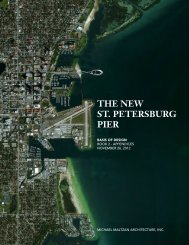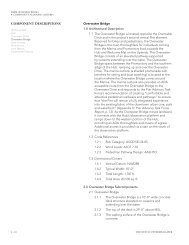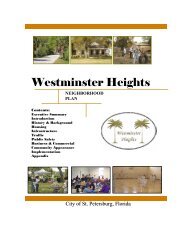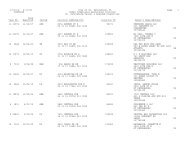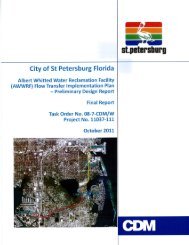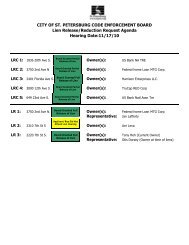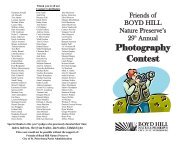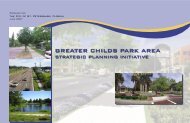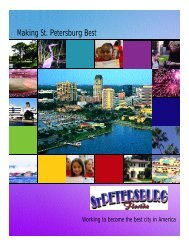Book 1 - City of St. Petersburg
Book 1 - City of St. Petersburg
Book 1 - City of St. Petersburg
You also want an ePaper? Increase the reach of your titles
YUMPU automatically turns print PDFs into web optimized ePapers that Google loves.
BASIS OF DESIGN BOOK 1<br />
3 GENERAL PLANNING CRITERIA<br />
UNDERWATER FEATURE<br />
CRITERIA<br />
Introduction<br />
An Underwater Feature at the center <strong>of</strong> the Lens, focused on life<br />
beneath the bay surface, has been an important concept since<br />
the initial design ideas. During the 10-week competition phase,<br />
the idea relied on cultivating oysters as a key habitat species<br />
that could provide a foundation for a diverse food web and an<br />
improvement in water clarity. Additionally, there was interest in<br />
re-using the piles <strong>of</strong> the existing pier as a structural framework<br />
for layers <strong>of</strong> habitat “trays” or nets to create a home for these<br />
species. During the competition, the team was advised by Jim<br />
Culter, a respected benthic scientist at Mote Marine Lab in<br />
Sarasota, and Robert Semmes <strong>of</strong> ATM, Coastal Engineers.<br />
Following the competition, the team began an outreach effort,<br />
organized by Janicki Environmental, to the local marine science<br />
community, as well as habitat restoration advocates and other<br />
stakeholders. A roundtable with members <strong>of</strong> the marine science<br />
and ocean communities generated some important comments,<br />
ideas, and suggestions for what the feature could entail,<br />
provided the availability <strong>of</strong> future funding.<br />
• Tampa Bay water is turbid by nature, leading to<br />
skepticism that oysters could significantly alter the water<br />
clarity given the exchange rates likely between waters<br />
inside and outside the Lens.<br />
• Due to its depth and location, the feature would need to<br />
resist strong waves.<br />
• Habitat creation should focus on creating a variety <strong>of</strong><br />
sheltered spaces and surfaces adaptable to all species<br />
typical for this location.<br />
• Use <strong>of</strong> equipment, such as cameras and audio phones,<br />
should be considered to facilitate monitoring and<br />
underwater imagery, both <strong>of</strong> which, when combined with<br />
nighttime lighting, could greatly improve public appeal.<br />
• The feature has great potential to enhance educational<br />
and research activities and the visibility <strong>of</strong> local marine<br />
science institutions, while simultaneously creating a<br />
framework for interested members <strong>of</strong> the <strong>St</strong>. <strong>Petersburg</strong><br />
community.<br />
Following the roundtable, the design team examined a variety <strong>of</strong><br />
options for artificial reef construction and imaging / monitoring<br />
technology. Reef options included both building up from the<br />
bay bottom with structures minimizing the “footprint”, and<br />
techniques for suspending reef modules from a structural<br />
framework anchored by the existing piles. After individual review<br />
with some members <strong>of</strong> the scientific community, several <strong>of</strong> these<br />
options have good possibilities for habitat generation, while<br />
appearing to be realizable at reasonable cost.<br />
3 - 108<br />
THE NEW ST. PETERSBURG PIER




